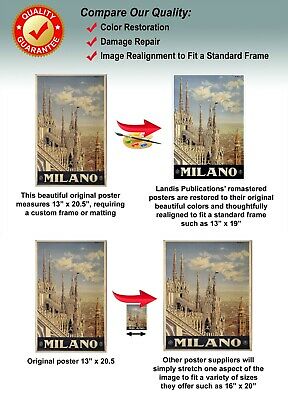-40%
Coca Cola Santa Claus - Vintage 1952 Christmas Poster
$ 10.53
- Description
- Size Guide
Description
These are simply the best posters available…you will be thrilled with the image quality, vivid colors, fine paper, and unique subjects!OUR POSTERS ARE SIZED FOR STANDARD OFF-THE-SHELF FRAMES, WITH NO CUSTOM FRAMING REQUIRED, PROVIDING HUGE COST SAVINGS!
This beautiful poster has been re-mastered from a 1952 Coca Cola Christmas advertisement featuring jolly old Saint Nick and children opening their Christmas presents.
The vibrant colors and detail of this classic image have been painstakingly brought back to life to preserve a great piece of history.
The high-resolution image is printed on heavy archival photo paper, on a large-format, professional giclée process printer. The poster is shipped in a rigid cardboard tube, and is ready for framing.
The 13"x19" format is an excellent image size that looks great as a stand-alone piece of art, or as a grouped visual statement. These posters require
no cutting, trimming, or custom framing
, and a wide variety of 13"x19" frames are readily available at your local craft or hobby retailer, and online.
A great vintage print for your home, shop, or business!
COCA COLA ADVERTISING HISTORY
Coca-Cola's advertising has significantly affected American culture, and it is frequently credited with inventing the modern image of Santa Claus as an old man in a red-and-white suit. Although the company did start using the red-and-white Santa image in the 1930s, with its winter advertising campaigns illustrated by Haddon Sundblom, the motif was already common.
Coca-Cola was not the first soft drink company to use the modern image of Santa Claus in its advertising: White Rock Beverages used Santa in advertisements for its ginger ale in 1923, after first using him to sell mineral water in 1915. Before Santa Claus, Coca-Cola relied on images of smartly dressed young women to sell its beverages. Coca-Cola's first such advertisement appeared in 1895, featuring the young Bostonian actress Hilda Clark as its spokeswoman.
1941 saw the first use of the nickname "Coke" as an official trademark for the product, with a series of advertisements informing consumers that "Coke means Coca-Cola". In 1971, a song from a Coca-Cola commercial called "I’d Like to Teach the World to Sing", produced by Billy Davis, became a hit single.
Coke's advertising is pervasive, as one of Woodruff's stated goals was to ensure that everyone on Earth drank Coca-Cola as their preferred beverage. This is especially true in southern areas of the United States, such as Atlanta, where Coke was born.
Some Coca-Cola television commercials between 1960 through 1986 were written and produced by former Atlanta radio veteran Don Naylor (WGST 1936–1950, WAGA 1951–1959) during his career as a producer for the McCann Erickson advertising agency. Many of these early television commercials for Coca-Cola featured movie stars, sports heroes, and popular singers.
During the 1980s, Pepsi-Cola ran a series of television advertisements showing people participating in taste tests demonstrating that, according to the commercials, "fifty percent of the participants who said they preferred Coke actually chose the Pepsi." Statisticians pointed out the problematic nature of a 50/50 result: most likely, the taste tests showed that in blind tests, most people cannot tell the difference between Pepsi and Coke. Coca-Cola ran ads to combat Pepsi's ads in an incident sometimes referred to as the cola wars; one of Coke's ads compared the so-called Pepsi challenge to two chimpanzees deciding which tennis ball was furrier. Thereafter, Coca-Cola regained its leadership in the market.
Selena was a spokesperson for Coca-Cola from 1989 until the time of her death. She filmed three commercials for the company. During 1994, to commemorate her five years with the company, Coca-Cola issued special Selena coke bottles.
The Coca-Cola Company purchased Columbia Pictures in 1982, and began inserting Coke-product images into many of its films. After a few early successes during Coca-Cola's ownership, Columbia began to under-perform, and the studio was sold to Sony in 1989.
Coca-Cola has gone through a number of different advertising slogans in its long history, including "The pause that refreshes", "I had like to buy the world a Coke", and "Coke is it".
In 2006, Coca-Cola introduced My Coke Rewards, a customer loyalty campaign where consumers earn points by entering codes from specially marked packages of Coca-Cola products into a website. These points can be redeemed for various prizes or sweepstakes entries.
In Australia in 2011, Coca-Cola began the "share a Coke" campaign, where the Coca-Cola logo was replaced on the bottles and replaced with first names. Coca-Cola used the 150 most popular names in Australia to print on the bottles. The campaign was paired with a website page, Facebook page, and an online "share a virtual Coke". The same campaign was introduced to Coca-Cola, Diet Coke & Coke Zero bottles and cans in the UK in 2013.
Coca-Cola has also advertised its product to be consumed as a breakfast beverage, instead of coffee or tea for the morning caffeine.












